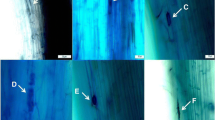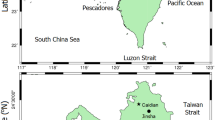Abstract
Zingiber Officinale is a perennial rhizomatous vegetable and seasonings with amazing flavor, as well as a wide range of pharmacological activity. Endophytic fungi live within plants, and some of them can help plants adapt to various stress and promote the growth and development of plant. Four endophytic fungi were isolated from ginger rhizome and named GR-1, GR-2, GR-3, and GR-4, respectively. GR-2 promoted the growth of tissue culture ginger plantlets in bottles, and it was identified as Sarocladium strictum. Thus, S. strictum might be a good candidate in the industry of tissue culture plantlet production.
Key message
The endophytic fungi S. strictum isolated from ginger rhizome promoted the growth of ginger tissue culture plantlets.




Similar content being viewed by others
Data availability
The data supporting the findings are available from the corresponding author upon request.
References
Anisha C, Radhakrishnan EK (2015) Gliotoxin-producing endophytic Acremonium sp. from Zingiber officinale found antagonistic to soft rot pathogen Pythium myriotylum. Appl Biochem Biotechnol 175:3458–3467. https://doi.org/10.1007/s12010-015-1517-2
Anisha C, Radhakrishnan EK (2017) Metabolite analysis of endophytic fungi from cultivars of Zingiber officinale Rosc. Identifies myriad of bioactive compounds including tyrosol. 3 Biotech 7:146–156. https://doi.org/10.1007/s13205-017-0768-8
Anisha C, Sachidanandan P, Radhakrishnan EK (2018) Endophytic paraconiothyrium sp. from Zingiber officinale Rosc. displays broad-spectrum antimicrobial activity by production of danthron. Curr Microbiol 75:343–352. https://doi.org/10.1007/s00284-017-1387-7
Chand K, Shah S, Sharma J, Paudel MR, Pant B (2020) Isolation, characterization, and plant growth-promoting activities of endophytic fungi from a wild orchid Vanda cristata. Plant Signal Behav 15:1744294–1744303. https://doi.org/10.1080/15592324.2020.1744294
Christakis CA, Daskalogiannis G, Chatzaki A, Markakis EA, Mermigka G, Sagia A, Rizzo GF, Catara V, Lagkouvardos L, Studholme DJ, Sarris PF (2021) Endophytic bacterial isolates from halophytes demonstrate phytopathogen biocontrol and plant growth promotion under high salinity. Front Microbiol 12:681567–681585. https://doi.org/10.3389/fmicb.2021.681567
Coutinho FP, Felix WP, Yano-Melo AM (2012) Solubilization of phosphates in vitro by Aspergillus spp. and Penicillium spp. Ecol Eng 42:85–89. https://doi.org/10.1016/jecoleng.2012.02.002
Ding C, Wang S, Li J, Wang Z (2022) Transcriptomic analysis reveals the mechanism of host growth promotion by endophytic fungus of Rumex gmelinii Turcz. Arch Microbiol 204:443–456. https://doi.org/10.1007/s00203-022-03072-9
El-Sayed ASA, Moustafa AH, Hussein HA, El-Sheikh AA, El-Shafey SN, Fathy NAM, Enan GA (2020) Potential insecticidal activity of Sarocladium strictum, an endophyte of Cynanchum acutum, against Spodoptera littoralis, a polyphagous insect pest. Biocatal Agric Biotechnol 24:101524–101535. https://doi.org/10.1016/j.bcab.2020.101524
Ginting RCB, Sukarno N, Widyastuti U, Darusman LK, Kanaya S (2013) Diversity of endophytic fungi from red ginger (Zingiber officinale Rosc.) plant and their inhibitory effect to Fusarium oxysporum plant pathogenic fungi. HAYATI J Biosci 20:127–137. https://doi.org/10.4308/hjb.20.3.127
Goswami J, Pandey RK, Tewari JP, Goswami BK (2008) Management of root knot nematode on tomato through application of fungal antagonists, Acremonium strictum and Trichoderma harzianum. J Environ Sci Heal B 43:237–240. https://doi.org/10.1080/03601230701771164
Gunatilaka AAL (2006) Natural products from plant-associated microorganisms: distribution, structural diversity, bioactivity, and implications of their occurrence. J Nat Prod 69:509–526. https://doi.org/10.1021/np058128n
Guo X, Yuan L, Shakeel M, Wan Y, Song Z, Wang D (2021) Screening of the plant growth-promoting mycorrhizal fungi in Guizhou blueberry. Rhizosphere 19:100389–100400. https://doi.org/10.1016/j.rhisph.2021.100389
Jalgaonwala RE, Mohite BV, Mahajan RT (2011) A review: natural products from plant associated endophytic fungi. J Microbiol Biotech Res 1:21–32. https://www.researchgate.net/publication/258884981
Li Y, Chi LD, Mao LG, Yan DD, Wu ZF, Ma TT, Guo MX, Wang QX, Ouyang CB, Cao AC (2014) First report of ginger rhizome rot caused by Fusarium oxysporum in China. Plant Dis 98:282. https://doi.org/10.1094/PDIS-07-13-0729-PDN
Liu H, Carvalhais LC, Crawford M, Singh E, Dennis PG, Pieterse CMJ, Schenk PM (2017) Inner plant values: diversity, colonization and benefits from endophytic bacteria. Front Microbiol 8:2552–2569. https://doi.org/10.3389/fmicb.2017.02552
Liu ZL, Wang Q, Song J, Zhou SY, Che JL, Chen TS (2019) Symbiotic fungi in ginger plants and their inhibiting effects against plant pathogens. Mycosystema 38:1958–1964. https://doi.org/10.13346/j.mycosystema.190144
Peng K, Hu X, Qin Y, He C, Li Y (2019) A study on tissue culture and rapid propagation of ginger. Agric Sci Technol 6:28–35. https://doi.org/10.16175/j.cnki.1009-4229.2019.06.004
Porras-Alfaro A, Bayman P (2011) Hidden fungi, emergent properties: endophytes and microbiomes. Annu Rev Phytopathol 49:291–315. https://doi.org/10.1146/annurev-phyto-080508-081831
Potshangbam M, Devi SI, Sahoo D, Strobel GA (2017) Functional characterization of endophytic fungal community associated with Oryza sativa L. and Zea mays L. Front Microbiol 8:325–340. https://doi.org/10.3389/fmicb.2017.00325
Racedo J, Salazar SM, Castagnaro AP, Díaz Ricci JC (2013) A strawberry disease caused by Acremonium strictum. Eur J Plant Pathol 137:649–654. https://doi.org/10.1007/s10658-013-0279-3
Regalado JJ, Berdion V, Vignale MV, Novas MV, Pitta-Alvarez SI, Iannone LJ (2018) The presence of Epichloë sp. in Bromus auleticus (trin.) seeds enhances micropropagation and growth of micropropagated plantlets from these seeds. Plant Cell Tiss Org 135:279–286. https://doi.org/10.1007/s11240-018-1462-1
Rojas EC, Jensen B, Jørgensen HJL, Latz MAC, Esteban P, Ding Y, Collinge DB (2020) Selection of fungal endophytes with biocontrol potential against Fusarium head blight in wheat. Biol Control 144:104222–104231. https://doi.org/10.1016/j.biocontrol.2020.104222
Schulz B, Römmert A, Dammann U, Aust H, Strack D (1999) The endophyte-host interaction: a balanced antagonism? Mycol Res 103:1275–1283. https://doi.org/10.1017/S0953756299008540
Seran TH (2013) In vitro propagation of ginger (Zingiber officinale Rosc.) Through direct organogenesis: a review. Pak J Biol Sci 16:1826–1835. https://doi.org/10.3923/pjbs.2013.1826.1835
Shah S, Shrestha R, Maharjan S, Selosse MA, Pant B (2019) Isolation and characterization of plant growth-promoting endophytic fungi from the roots of Dendrobium moniliforme. Plants (Basel) 8:5–16. https://doi.org/10.3390/plants8010005
Singh S, Mathur N (2010) In vitro studies of antagonistic fungi against the root-knot nematode, Meloidogyne incognita. Biocontrol Sci Techn 20:275–282. https://doi.org/10.1080/09583150903484318
Sun X, Wang B (2009) Research review on the diseases of ginger. AnHui Agri Sci Bull 15:159–161. https://doi.org/10.3969/j.issn.1007-7731.2009.10.090
Suryanarayanan TS, Wittlinger SK, Faeth SH (2005) Endophytic fungi associated with cacti in Arizona. Mycol Res 109:635–639. https://doi.org/10.1017/S0953756205002753
Tian W, Ge Y, Liu X, Dou G, Ma Y (2019) Identification and characterization of Populus microRNAs in response to plant growthpromoting endophytic Streptomyces sp. SSD49. World J Microb Biot 35:97–108. https://doi.org/10.1007/s11274-019-2671-4
Verma P, Khan SA, Mathur AK, Shanker K, Kalra A (2014) Fungal endophytes enhanced the growth and production kinetics of Vinca minor hairy roots and cell suspensions grown in bioreactor. Plant Cell Tiss Org 118:257–268. https://doi.org/10.1007/s11240-014-0478-4
Wang Q, Qin X, Chen Y, Zhou S, Song J (2022) Preventive effects of Arbuscular mycorrhizal fungi and dark septate endophytes on ginger and the anti-disease mechanism. Microbiol China 50:788–801. https://doi.org/10.13344/j.microbiol.china.220776
Waqas M, Khan AL, Hamayun M, Shahzad R, Kang S, Kim J, Lee I (2015) Endophytic fungi promote plant growth and mitigate the adverse effects of stem rot: an example of Penicillium citrinum and Aspergillus terreus. J Plant Interact 10:280–287. https://doi.org/10.1080/17429145.2015.1079743
White JF, Kingsley KL, Zhang Q, Verma R, Obi N, Dvinskikh S, Elmore MT, Verma SK, Gond SK, Kowalski KP (2019) Review: endophytic microbes and their potential applications in crop management. Pest Manag Sci 75:2558–2565. https://doi.org/10.1002/ps.5527
Yu C, Yao Y (2022) Diversity, biocontrol, and growth promotion potential of culturable endophytic fungi isolated from root, shoot, and leaf of wild Phoebe bournei Yang across seasons. Can J Forest Res 52:175–187. https://doi.org/10.1139/cjfr-2021-0078
Acknowledgements
This work was supported by the Science and Technology Innovation and Entrepreneurship Project of Ya’an, and Science and Technology Planning Project of Ya’an (22ZDYFZF0009).
Author information
Authors and Affiliations
Contributions
M. Y. conceived the idea and revised the manuscript. Y. C., Z. Z., and S. Y. designed the experiments. Z. T., L. Z., T. C., S. F., and C. D. analyzed and processed the original data. X. L. isolated and purified the endophytic fungi from ginger rhizome. J. W. identified the endophytic fungi. Y. P. observed the morphology of endophytic fungi. S. Z. completed the co-cultivation experiment of endophytic fungi and ginger tissue culture plantlets. S. Z. and Y. P. wrote the manuscript and contributed equally to this work. All the authors have reviewed and approved the manuscript.
Corresponding author
Ethics declarations
Competing interests
The authors declare no competing interests.
Additional information
Communicated by Sergey V Dolgov.
Publisher’s note
Springer Nature remains neutral with regard to jurisdictional claims in published maps and institutional affiliations.
These authors contributed equally: Shuting Zhang and Yinghong Pei
Rights and permissions
Springer Nature or its licensor (e.g. a society or other partner) holds exclusive rights to this article under a publishing agreement with the author(s) or other rightsholder(s); author self-archiving of the accepted manuscript version of this article is solely governed by the terms of such publishing agreement and applicable law.
About this article
Cite this article
Zhang, S., Pei, Y., Wang, J. et al. Isolation and characterization of an endophytic fungi from Zingiber officinale Rosc. and its activity to promote the growth of tissue culture ginger plantlets in bottles. Plant Cell Tiss Organ Cult 154, 587–594 (2023). https://doi.org/10.1007/s11240-023-02534-2
Received:
Accepted:
Published:
Issue Date:
DOI: https://doi.org/10.1007/s11240-023-02534-2




